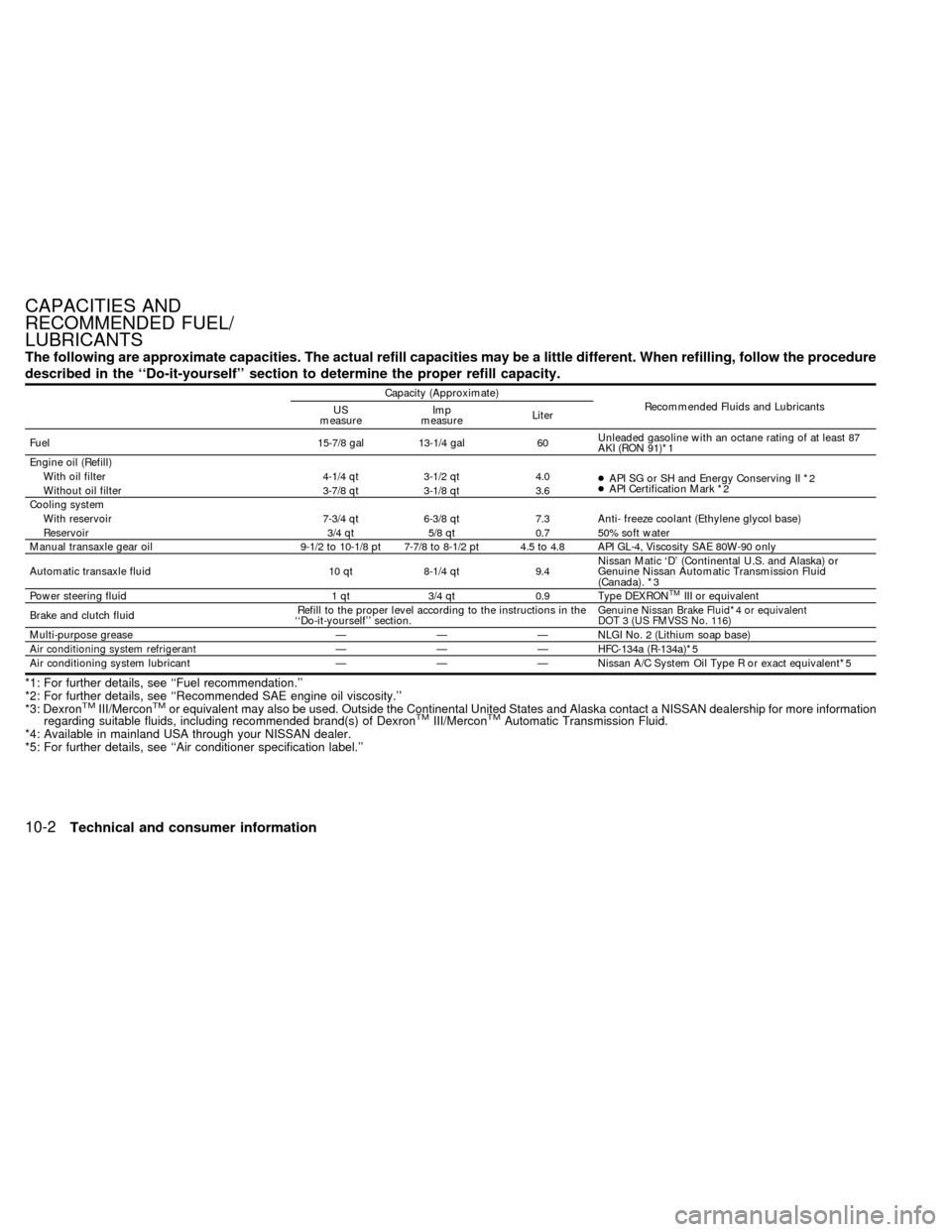1998 NISSAN ALTIMA oil type
[x] Cancel search: oil typePage 133 of 217

Installing the spare tire
The T-type spare tire is designed for
emergency use. See specific instruc-
tions under the heading ``Wheels and
tires'' in the ``Do-it-yourself'' section.
1. Clean any mud or dirt from the surface
between the wheel and hub.
2. Carefully put the spare tire on and install
the wheel nuts finger-tight.
3. With the wheel nut wrench, tighten wheel
nuts alternately and evenly until they are
tight.4. Lower the vehicle slowly until the tire
touches the ground. Then, with the wheel
nut wrench, tighten the wheel nuts se-
curely in the sequence as illustrated.
Lower the vehicle completely.
WARNING
cIncorrect wheel nuts or improperly
tightened wheel nuts can cause the
wheel to become loose or come off.
This could cause an accident.cDo not use oil or grease on the wheel
studs or nuts. This could cause the
nuts to become loose.
As soon as possible, tighten the wheel
nuts to the specified torque with a torque
wrench.
Wheel nut tightening torque:
72 to 87 ft-lb
(98 to 118 Nzm)
Adjust tire pressure to the COLD pres-
sure.
COLD pressure: After vehicle has been
parked for three hours or more or driven
less than 1 mile (1.6 km).
COLD tire pressures are shown on the tire
placard affixed to the driver's door, center
pillar.
cRetighten the wheel nuts when the
vehicle has been run for 600 miles
(1,000 km).
5. With the spare tire installed on the ve-
hicle, place the damaged tire in the spare
tire storage area. Put the jack rod and
wheel nut wrench in the tool bag and
CE1030CE1082
6-6In case of emergency
ZX
Page 189 of 217

The following are approximate capacities. The actual refill capacities may be a little different. When refilling, follow the procedure
described in the ``Do-it-yourself'' section to determine the proper refill capacity.
Capacity (Approximate)
Recommended Fluids and Lubricants
US
measureImp
measureLiter
Fuel 15-7/8 gal 13-1/4 gal 60Unleaded gasoline with an octane rating of at least 87
AKI (RON 91)*1
Engine oil (Refill)
With oil filter 4-1/4 qt 3-1/2 qt 4.0
cAPI SG or SH and Energy Conserving II *2
cAPI Certification Mark *2
Without oil filter 3-7/8 qt 3-1/8 qt 3.6
Cooling system
With reservoir 7-3/4 qt 6-3/8 qt 7.3 Anti- freeze coolant (Ethylene glycol base)
Reservoir 3/4 qt 5/8 qt 0.7 50% soft water
Manual transaxle gear oil 9-1/2 to 10-1/8 pt 7-7/8 to 8-1/2 pt 4.5 to 4.8 API GL-4, Viscosity SAE 80W-90 only
Automatic transaxle fluid 10 qt 8-1/4 qt 9.4
Nissan Matic `D' (Continental U.S. and Alaska) or
Genuine Nissan Automatic Transmission Fluid
(Canada). *3
Power steering fluid 1 qt 3/4 qt 0.9 Type DEXRONTMIII or equivalent
Brake and clutch fluidRefill to the proper level according to the instructions in the
``Do-it-yourself'' section.Genuine Nissan Brake Fluid*4 or equivalent
DOT 3 (US FMVSS No. 116)
Multi-purpose grease Ð Ð Ð NLGI No. 2 (Lithium soap base)Air conditioning system refrigerantÐ Ð Ð HFC-134a (R-134a)*5
Air conditioning system lubricant Ð Ð Ð Nissan A/C System Oil Type R or exact equivalent*5
*1: For further details, see ``Fuel recommendation.''
*2: For further details, see ``Recommended SAE engine oil viscosity.''
*3: Dexron
TMIII/MerconTMor equivalent may also be used. Outside the Continental United States and Alaska contact a NISSAN dealership for more information
regarding suitable fluids, including recommended brand(s) of DexronTMIII/MerconTMAutomatic Transmission Fluid.
*4: Available in mainland USA through your NISSAN dealer.
*5: For further details, see ``Air conditioner specification label.''
CAPACITIES AND
RECOMMENDED FUEL/
LUBRICANTS
10-2Technical and consumer information
ZX
Page 192 of 217

ENGINE OIL AND OIL FILTER
RECOMMENDATION
Selecting the correct oil
It is essential to choose engine oil with the
correct quality and viscosity oil to ensure
satisfactory engine life and performance.
NISSAN recommends the use of a low
friction oil (energy conserving oil) in order to
improve fuel economy and conserve en-
ergy. Oils which do not have the specified
quality label should not be used as they
could cause engine damage.Only those engine oils with the American
Petroleum Institute (API) CERTIFICATION
MARK on the front of the container should
be used. This type of oil supersedes the
existing API SG or SH and Energy Conserv-
ing II categories.
If you cannot find engine oil with the CERTI-
FICATION MARK, an API SG or SH an
Energy Conserving II oil with the API Service
Symbol may be used. An oil with a single
designation SG or SH, or in combination with
other categories (for example, SG/CC or
SG/CD) may also be used if one with the API
CERTIFICATION MARK cannot be found.
Mineral based or synthetic type oils may be
used in your NISSAN vehicle. These oils
must however, meet the API quality and
SAE viscosity ratings specified for your ve-
hicle. Do not mix mineral based and syn-
thetic type oils in the engine.
Oil additives
NISSAN does not recommend the use of oil
additives. The use of an oil additive is not
necessary when the proper oil type is used
and maintenance intervals are followed.
Oil which may contain foreign matter or has
been previously used should not be used.
Oil viscosity
The engine oil viscosity or thickness
changes with temperature. Because of this,
it is important that the engine oil viscosity be
selected based on the temperatures at
which the vehicle will be operated before
the next oil change. The chart ``Recom-
mended SAE viscosity number'' shows the
recommended oil viscosities for the ex-
pected ambient temperatures. Choosing an
oil viscosity other than that recommended
could cause serious engine damage.
ATI0507
Technical and consumer information10-5
ZX
Page 194 of 217

AIR CONDITIONER SYSTEM
REFRIGERANT AND LUBRICANT
RECOMMENDATIONS
The air conditioner system in this NIS-
SAN vehicle must be charged with the
refrigerant HFC-134a (R-134a) and the
lubricant, NISSAN A/C system oil Type R
or the exact equivalents.
CAUTION
Use of any other refrigerant or lubricant
will cause severe damage and you will
need to replace your vehicle's entire air
conditioner system.
The refrigerant HFC-134a (R-134a) in your
NISSAN vehicle does not harm the earth's
ozone layer. Although this refrigerant does
not affect the earth's atmosphere, certain
government regulations require the recov-
ery and recycling of any refrigerant during
automotive air conditioner system service.
An authorized NISSAN dealer has the
trained technicians and equipment needed
to recover and recycle your air conditioner
system refrigerant.
Contact an authorized NISSAN dealer when
servicing your air conditioner system.
Technical and consumer information
10-7
ZX
Page 213 of 217

O
Octane rating (See fuel octane rating) ...... 10-3
Odometer ..................................................... 2-3
Oil
Capacities and recommended fuel/
lubricants .............................................. 10-2
Changing engine oil................................ 8-8
Changing engine oil filter........................ 8-9
Checking engine oil level ....................... 8-7
Engine oil ................................................ 8-7
Engine oil and oil filter
recommendation ................................... 10-5
Engine oil viscosity ............................... 10-5
Outside mirror control ................................ 3-13
Overdrive switch .......................................... 5-8
Overheat
If your vehicle overheats ........................ 6-9
Owner's manual/service manual order
forms ........................................................ 10-21
P
Parking
Parking brake check ............................. 8-18
Parking brake operation ....................... 5-11
Parking/parking on hills ........................ 5-15
Periodic maintenance schedules ................. 9-5
Power
Power antenna ..................................... 4-26
Power door lock...................................... 3-3Power steering fluid .............................. 8-11
Power steering system ......................... 5-16
Power support front seat ........................ 1-5
Power windows..................................... 2-17
Precautions
Maintenance precautions ....................... 8-2
Precautions on seat belt usage............ 1-14
Precautions when starting and driving ... 5-2
Push starting ................................................ 6-9
R
Radio
AM-FM radio with cassette player ........ 4-10
AM-FM radio with compact disc
player .................................................... 4-15
AM-FM radio with cassette player and
compact disc player ............................ 4-20
CB radio or car phone .......................... 4-27
Cassette tape operation ....................... 4-23
Compact disc (CD) player operation .... 4-25
Readiness for inspection maintenance
(I/M) test................................................... 10-20
Rear seat ..................................................... 1-6
Rear window defogger switch ................... 2-11
Registering your vehicle in another
country ..................................................... 10-10
Remote keyless entry system (See
multi-remote control system) ....................... 3-4
Reporting safety defects (USA) ............... 10-19S
Safety
Child safety rear door lock ..................... 3-4
Reporting safety defects (USA) .......... 10-19
Seat belt
2-point type without retractor
(rear center lap belt) ............................. 1-20
3-point type with retractor..................... 1-17
Precautions on seat belt usage............ 1-14
Seat belt extenders .............................. 1-22
Seat belt maintenance.......................... 1-22
Seat belts.............................................. 1-14
Shoulder belt height adjustment ........... 1-19
Seat belt warning light ................................. 2-6
Seats
Front seats.............................................. 1-2
Manual front seat adjustment ................. 1-3
Power support front seat ........................ 1-5
Rear seat ................................................ 1-6
Servicing air conditioner .............................. 4-9
Shifting
Automatic transmission .......................... 5-7
Manual transmission............................... 5-9
Shoulder belt height adjustment ................ 1-19
Spark plug replacement............................. 8-14
Speedometer ............................................... 2-3
Starting
Before starting the engine ...................... 5-5
Jump starting................................. 6-7, 8-13
Precautions when starting and driving ... 5-2
Push starting........................................... 6-9
11-4
ZX